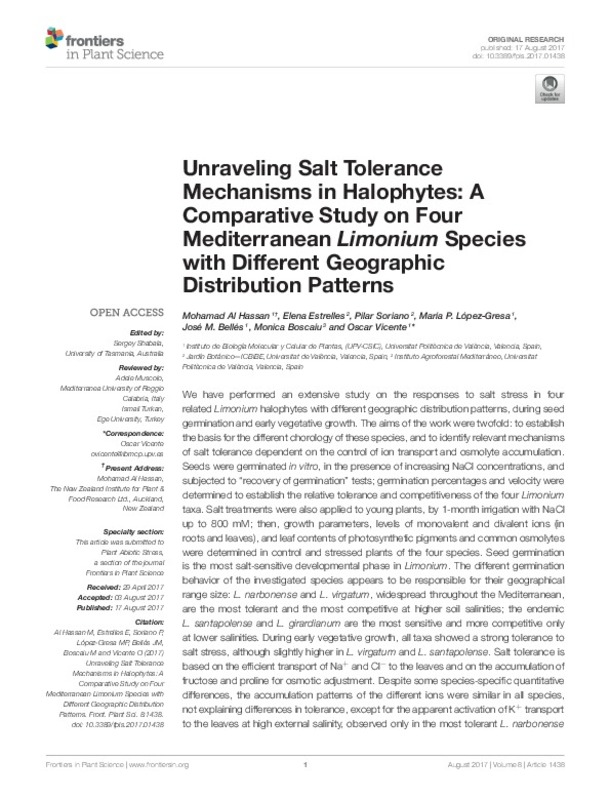JavaScript is disabled for your browser. Some features of this site may not work without it.
Buscar en RiuNet
Listar
Mi cuenta
Estadísticas
Ayuda RiuNet
Admin. UPV
Unraveling Salt Tolerance in Halophytes: A Comparative Study on Four Mediterranean Limonium Species with Different Geographic Distribution Patterns
Mostrar el registro sencillo del ítem
Ficheros en el ítem
| dc.contributor.author | Al Hassan, Mohamad
|
es_ES |
| dc.contributor.author | Estrelles, Elena
|
es_ES |
| dc.contributor.author | Soriano, Pilar
|
es_ES |
| dc.contributor.author | López-Gresa, María Pilar
|
es_ES |
| dc.contributor.author | Belles Albert, José Mª
|
es_ES |
| dc.contributor.author | Boscaiu, Monica
|
es_ES |
| dc.contributor.author | Vicente, Oscar
|
es_ES |
| dc.date.accessioned | 2018-05-12T04:17:59Z | |
| dc.date.available | 2018-05-12T04:17:59Z | |
| dc.date.issued | 2017 | es_ES |
| dc.identifier.uri | http://hdl.handle.net/10251/101792 | |
| dc.description.abstract | [EN] We have performed an extensive study on the responses to salt stress in four related Limonium halophytes with different geographic distribution patterns, during seed germination and early vegetative growth. The aims of the work were twofold: to establish the basis for the different chorology of these species, and to identify relevant mechanisms of salt tolerance dependent on the control of ion transport and osmolyte accumulation. Seeds were germinated in vitro, in the presence of increasing NaCl concentrations, and subjected to ¿recovery of germination¿ tests; germination percentages and velocity were determined to establish the relative tolerance and competitiveness of the four Limonium taxa. Salt treatments were also applied to young plants, by 1-month irrigation with NaCl up to 800 mM; then, growth parameters, levels of monovalent and divalent ions (in roots and leaves), and leaf contents of photosynthetic pigments and common osmolytes were determined in control and stressed plants of the four species. Seed germination is the most salt-sensitive developmental phase in Limonium. The different germination behavior of the investigated species appears to be responsible for their geographical range size: L. narbonense and L. virgatum, widespread throughout the Mediterranean, are the most tolerant and the most competitive at higher soil salinities; the endemic L. santapolense and L. girardianum are the most sensitive and more competitive only at lower salinities. During early vegetative growth, all taxa showed a strong tolerance to salt stress, although slightly higher in L. virgatum and L. santapolense. Salt tolerance is based on the efficient transport of Na+ and Cl¿ to the leaves and on the accumulation of fructose and proline for osmotic adjustment. Despite some species-specific quantitative differences, the accumulation patterns of the different ions were similar in all species, not explaining differences in tolerance, except for the apparent activation of K+ transport to the leaves at high external salinity, observed only in the most tolerant L. narbonense and L. virgatum. This specific response may be therefore relevant for salt tolerance in Limonium. The ecological implications of these results, which can contribute to a more efficient management of salt marshes conservation/regeneration programs, are also discussed. | es_ES |
| dc.description.sponsorship | This work was financed by internal funds of the University of Valencia (to PS and EE) and of the Polytechnic University of Valencia (to MB and OV) | |
| dc.language | Inglés | es_ES |
| dc.publisher | Frontiers Media SA | es_ES |
| dc.relation.ispartof | Frontiers in Plant Science | es_ES |
| dc.rights | Reconocimiento (by) | es_ES |
| dc.subject | Climate change | es_ES |
| dc.subject | Ion transport | es_ES |
| dc.subject | Osmolytes | es_ES |
| dc.subject | Salinity tolerance | es_ES |
| dc.subject | Salt glands | es_ES |
| dc.subject | Salt marsh | es_ES |
| dc.subject | Salt stress | es_ES |
| dc.subject | Seed germination | es_ES |
| dc.subject.classification | BOTANICA | es_ES |
| dc.subject.classification | BIOQUIMICA Y BIOLOGIA MOLECULAR | es_ES |
| dc.title | Unraveling Salt Tolerance in Halophytes: A Comparative Study on Four Mediterranean Limonium Species with Different Geographic Distribution Patterns | es_ES |
| dc.type | Artículo | es_ES |
| dc.identifier.doi | 10.3389/fpls.2017.01438 | es_ES |
| dc.rights.accessRights | Abierto | es_ES |
| dc.contributor.affiliation | Universitat Politècnica de València. Departamento de Biotecnología - Departament de Biotecnologia | es_ES |
| dc.contributor.affiliation | Universitat Politècnica de València. Departamento de Ecosistemas Agroforestales - Departament d'Ecosistemes Agroforestals | es_ES |
| dc.description.bibliographicCitation | Al Hassan, M.; Estrelles, E.; Soriano, P.; López-Gresa, MP.; Belles Albert, JM.; Boscaiu, M.; Vicente, O. (2017). Unraveling Salt Tolerance in Halophytes: A Comparative Study on Four Mediterranean Limonium Species with Different Geographic Distribution Patterns. Frontiers in Plant Science. 8. https://doi.org/10.3389/fpls.2017.01438 | es_ES |
| dc.description.accrualMethod | S | es_ES |
| dc.relation.publisherversion | http://doi.org/10.3389/fpls.2017.01438 | es_ES |
| dc.type.version | info:eu-repo/semantics/publishedVersion | es_ES |
| dc.description.volume | 8 | es_ES |
| dc.identifier.eissn | 1664-462X | es_ES |
| dc.identifier.pmid | 28861106 | |
| dc.identifier.pmcid | PMC5562691 | |
| dc.relation.pasarela | S\341877 | es_ES |
| dc.contributor.funder | Universitat de València | |
| dc.contributor.funder | Universitat Politècnica de València |








